AWOL Part 2 ... Northern Swing
My first destination heading north was Yellowstone National Park, but first a whimsical detour to Henefer, Utah to check on the Sage Grouse lek I saw last year. I knew from last year that if the grouse were still there they would be too distant for any reasonable photographs. However, it would be fascinating to watch the Sage Grouse again if the lek still existed. The property was for sale last year. Maybe the lek was replaced by some development. After that it would be north to Yellowstone and then northeast across Montana to look for a few prairie birds.
**************************************************************************************

Henefer was only about an hour out of the way. It was already 9:00 am and maybe too late for the lek if it still existed. I tempered my anticipation with a little pessimism to prepare for the worse, but my diversion was rewarded. As I eased up to the field I could see white fluff balls moving around. About 50 Sage Grouse were busily engrossed in their mating activities. As I suspected, the grouse were too distant for decent photos, but it was exciting to see the lek again. I enjoyed the lek for about five minutes before the grouse suddenly took flight and moved further into the foothills.

After the grouse disappeared I turned my attention to the sparrows. The field was busy with sparrows foraging and flitting from one sagebrush to another. Most of them appeared to be Vesper Sparrows.

I managed to photograph 5 different birds, and they were all Vespers.

On the way out of Henefer I spotted a nest in grove of tall trees. I quickly pulled off the road and was greeted by 6 curious eyes. The adult Great Horned Owl soon went back to sleep, but the nestlings remained curious. I was tempted to stay in the area for a better shot later in the day, but it was time to move on.
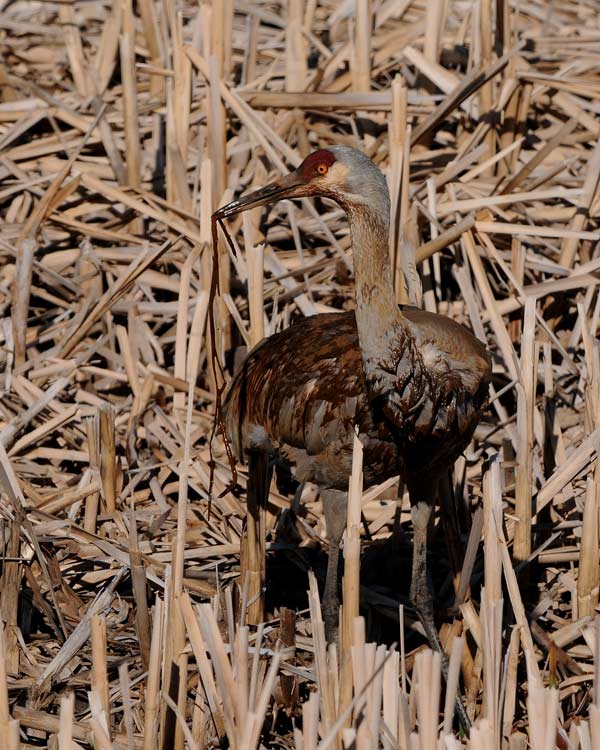
I didn't move very far when I spotted a lone Sandhill Crane just off the road. I don't know what it had been doing, but it was covered with mud.

As I neared Yellowstone a hawk on a fence warranted another stop. In my rush to point the camera out the window I somehow bumped my zoom ring to 300 mm, otherwise, I would have gotten a great full-frame shot of the beautiful dark morph Swainson's Hawk. I was lucky to get one shot before the hawk flew. As it turned out, the Swainson's was the most common hawk I saw on the prairies.

Due to some confusion I had booked a motel in Gardiner, Montana and not West Yellowstone. As a consolation I got to see another Great Horned Owl just as the sun was setting.
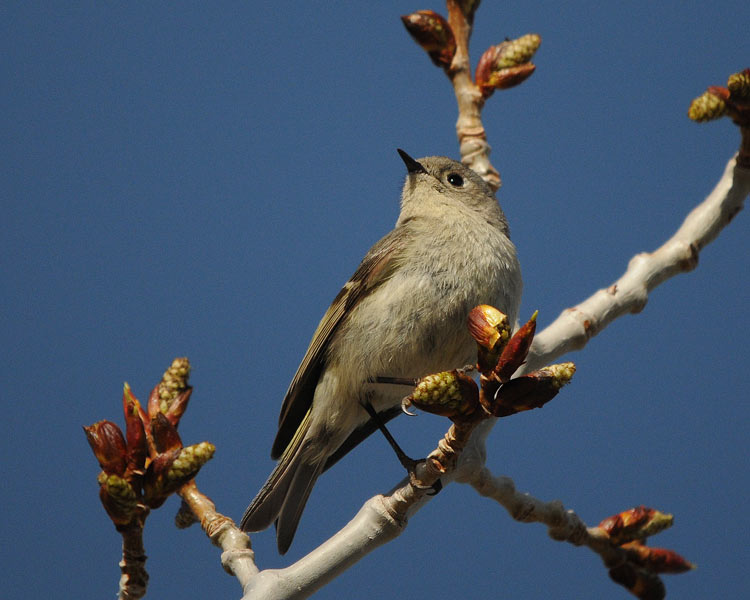
It was still winter in Yellowstone. Half the park was still closed because of snow. Birds were still pretty scarce. One of the first birds I encountered was a very active Ruby-crowned Kinglet.

I wasn't surprised to see a few Mountain Bluebirds. They aren't called mountain for nothing. It was nest-building time for this female.

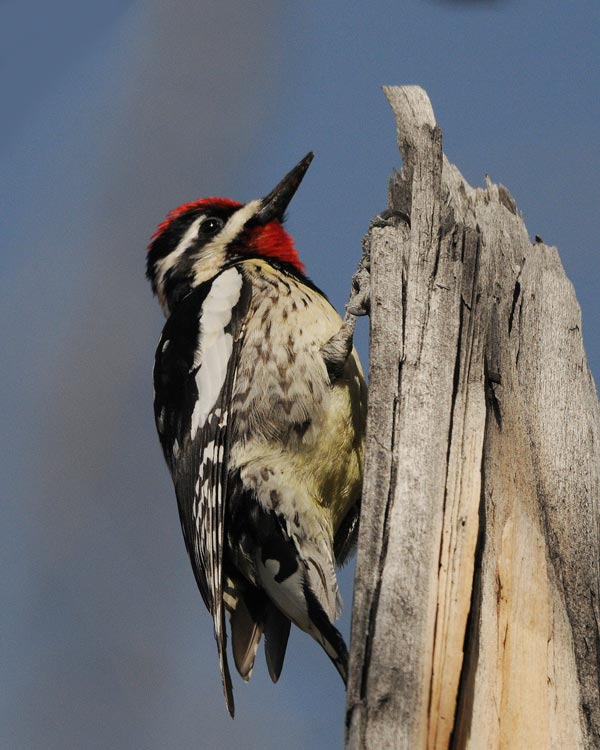
Next I encountered a Sapsucker busily drilling a hole in a snag. As far as I can figure using Sibley's Field Guide, it was a Red-naped.

I heard from another photographer that there was a Harlequin Duck in the Yellowstone River. When I got there all I could find were Barrow's Goldeneyes. I saw at least 50 in various locations along the river. I assumed that many of them would be nesting in the area.

It was a pleasure to see the Barrow's in its nesting area. The only other ducks I saw in the river were a pair of Buffleheads and a male Common Merganser.

With half of Yellowstone still closed because of winter, it was time to move on. Heading north in Montana I spotted a swan nesting by a slough close to highway. I thought all Trumpeters nested further north. I learn something new every day.

As I neared northeastern Montana, I was into pothole country. There were puddles, ponds, and small lakes everywhere. Even the puddle-sized ponds seemed to be home for at least a pair of ducks. One fairly large roadside puddle was full of shorebirds as well as ducks. I couldn't turn down another opportunity to photograph an American Avocet photo.

Wilson's Phalaropes were busily foraging along the margin of the puddle. The larger and more colourful phalarope is the female.

The male is smaller and less colourful tan the female. Like most shorebirds their non-stop foraging made them difficult subjects for the camera. Catching the catch-light was almost impossible.

Shortly after a striking black bird on the fence caught my attention. It was a bird I had never seen before.

I was lucky to get a few record shots before they flew. A quick check in Sibley's confirmed the Lark Bunting.

One of my Montana destinations was Beaudoin NWR near Malta which proved to be rich in avian species. We arrived in the late afternoon a did the self-guided tour. Ducks such as the Gadwall were abundant.

Franklin's Gulls were abundant and everywhere. I stopped at a field where they were hawking insects and worked on some flight shots.

Blue-winged Teals were another common duck.

I saw several Eastern Kingbirds. Most of them were on various barbed-wire fences.

I finally encountered some Franklin's foraging on the ground. This was much easier than flight shots.

While I was shooting the Franklin's a large shorebird joined the party. It was a Marbled Godwit. Before the tour was over I saw many other shorebirds such as Avocets, Stilts, Dowitchers, and sandpipers.

As you might have expected, there were an abundance of sparrows. Most of the ones I could identify were Vespers. I think they have a tendency to sit up and be noticed compared to the other species just like this one.

I stayed in Malta that night and in the morning I decided to check out a nearby farm road. As I suspected the farm fences were alive with sparrows. The first cooperative non-Vesper I found was a perky Grasshopper.

Unlike the many other sparrows that disappeared when a car passed, the Grasshopper conveniently (for me) moved down the fence.

It finally flitted to a sagebrush and continued singing.

Next we passed a Loggerhead Shrike that eyed me curiously. I reciprocated by sticking the camera out an taking its picture.

Trees were scarce on the prairie landscape. When I finally came to one by the road, it was occupied by a large hawk. Angling the car off the road, I was able to snap a few backlit shots of the Swainson's.

While I was photographing the first hawk, a second one flew in. I had just enough room to stick my head out the window for a quick shot. It was a great result for a hurried shot.

After I drove by the tree and returned, the first hawk had repositioned to the sunny side where it posed kindly for a few more snaps.

When I finished with the farm road, I returned to Beaudoin for a morning visit. Oh yes, the pheasants. I had never seen so many pheasants. They were everywhere not just at Beaudoin but everywhere in region.

As usual the pheasants were gorgeous but extremely elusive to photograph.

However, when you get multiple opportunities, you're bound to get a few reasonable shots. This one just wasn't just fanning its wings. It was also bugling.
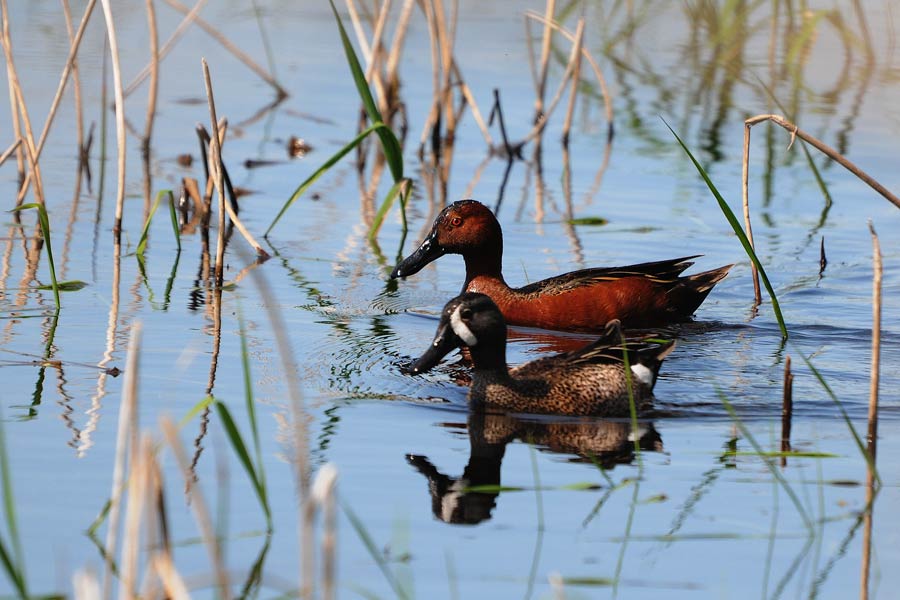
I told you there were ducks all over. Here's a teal-teal combo with the Blue-winged and Cinamon.

Long-tailed Blackbirds? Yes, they are called Common Grackles. I couldn't get close to one yesterday out in the fields, but I noticed that they liked foraging around the ponds.

I finally snuck up to a couple that were busy foraging at the edge of the pond.

A few Wilson's Phalaropes were in the same pond. I waited for one to swim ito the sunlight for a decent shot.

On the way east to Westby I checked out Medicine Lake NWR. The first bird I saw clearly was a Burrowing Owl standing over its burrow.

As usual songbirds were abundant but usually not cooperative for photos. The first decent opportunity I got just happened to be a splendid Chestnut-collared Longspur.

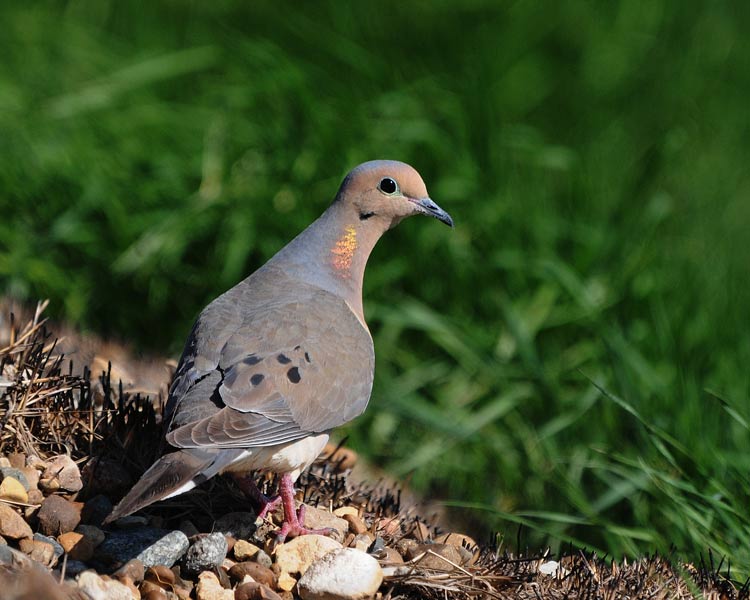
Like the pheasants, the Mourning Doves were abundant and also very wary. I was lucky to catch this photo before it flew.

Just a bit down the road a shorebird landed in front of the car. It was another Marbled Godwit. I previously mentioned that a godwit flew in on me yesterday at Beudoin. It happened today, and it would also happen in Saskatchewan. I certainly had no objections as it is a great bird to see.

A second godwit also landed nearby in the grass.

My last Montana destination was Westby which was right on the North Dakota border. Unfortunately, it was windy. I did check out the city park which was full of towering deciduous trees. I could see why it is a great migrant trap, and ideal for birders. But, it was a challenge for photography in terms of proximity and lighting. I did see an American Redstart, Orange-crowned Warbler, and a couple of Yellow-rumpeds but had no photo ops. With the high winds I decided cut short Westby visit. After a comfortable night at the only Westby B&B I headed west, but not before a little farm road birding and a portrait of a very obliging Wilson's Snipe.
**************************************************************************************
Bird Poster
My poster is on display at: Victoria - Swan Lake Nature House

**************************************************************************************
PUBLICATIONS



VOLUME I & II BOOKS AVAILABLE AT
PARKSVILLE & QUALICUM - MULBERRYBUSH BOOKSTORES
NANAIMO - SAVE-ON FOODS (WOODGROVE),
SAVE-ON FOODS (COUNTRY CLUB), CHAPTERS, FALCONER BOOKS
PORT ALBERNI - CLOCKTOWER GALLERY
COURTENAY - GRAHAM'S JEWELLERS
SIDNEY - VICTORIAN BIRD HOUSE, TANNER'S BOOKSTORE
COMOX - BLUE HERON BOOKS
BOWSER - LIGHTHOUSE GIFTS
DEEP BAY - SHIP & SHORE
SAANICH - WILD BIRDS UNLIMITED
VICTORIA - BOLEN BOOKS, MUNRO'S, CROWN PUBLICATIONS, IVY'S
CAMPBELL RIVER - SAVE-ON FOODS, COHO BOOKS, CAMPBELL RIVER MUSEUM
DUNCAN - VOLUME 1 BOOKSTORE
CHEMAINUS - WILLOW"S WILD BIRD STORE
LADYSMITH - SALAMANDER BOOKS
NANOOSE - SCHOONER COVE MARINA
LAKE COWICHAN - GALLOPING MOON GALLERY
TOFINO - BOTANICAL GARDENS
QUADRA ISLAND - EXPLORE & BOOK BONANZA
LANGFORD - WILD BIRD CENTER
SOOKE - READING ROOM BOOKSTORE
SOOKE - MUSEUM
Port Hardy - MUSEUM
[RETURN TO CONTENTS PAGE]
Comments, questions, or book orders?
[Contact Mike]
[Contact Mike]